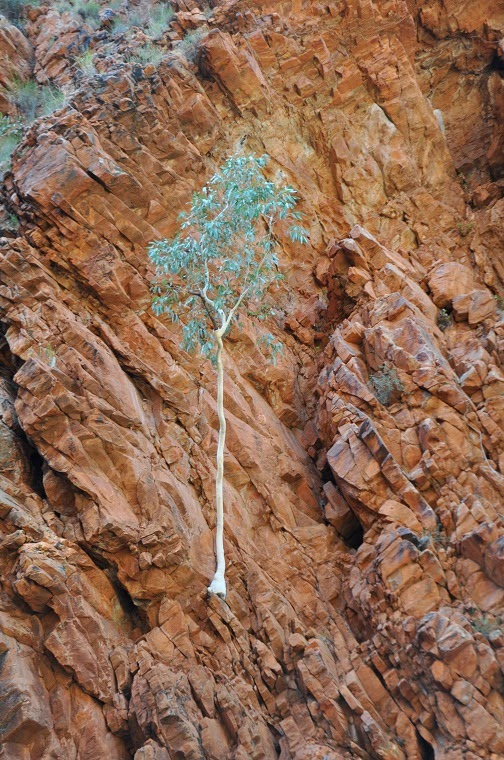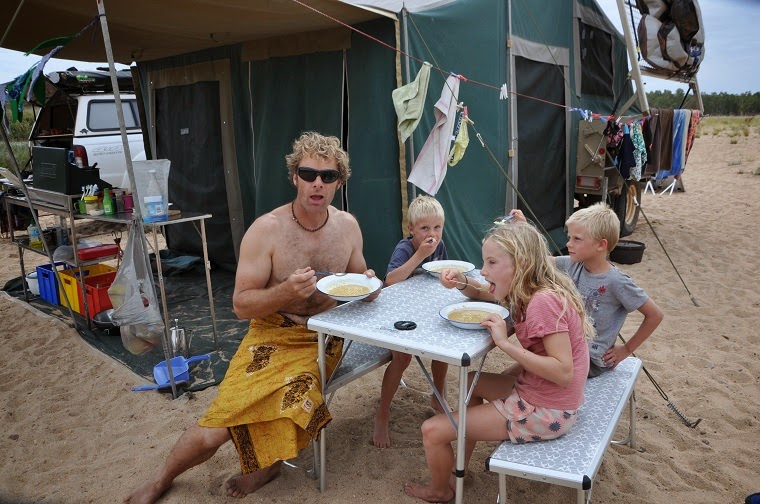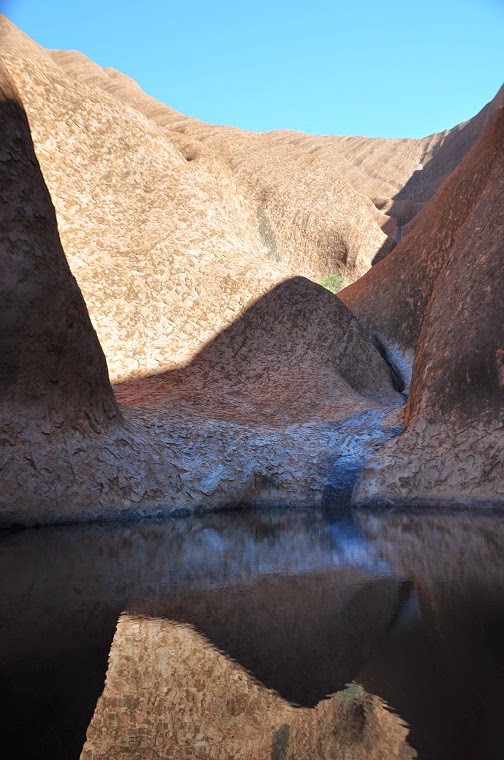Hello to you all, I hope the winter is going well in Vicco
or your spring/start of summer is happening in the UK. We have now left the
resort living behind and headed into the MacDonnell Ranges from Kings Canyon
via the Mereenie Loop.
The road to the MacDonnell Ranges was really rough; probably
worse than the Oodnadatta Track. The road runs through Aboriginal owned land,
thus we had to purchase a permit to travel its route.
Our first destination was south in the ranges to a place
called Palm Valley where high clearance 4x4 vehicle access is recommended. It
is a beautiful long, slow 18km’s to the bush camp which by the way is brilliant
with showers, flushing toilets and BBQ’s. Upon arrival there we were greeted by
the ranger who informed us there were lots of frogs around and please use head
torches at night because he had already removed two Mulgas (king Browns….a
really gnarly snake) from the dunny block!
Now for those of you who don’t know this is arguably Central
Australia’s most aggressive snake when provoked (not that I planned on a
Mexican stand-off with one anyway). He also told us there were lots of Dingos
around and make sure you put everything away……..
Now on the first night there we were sat around the fire
when…… after putting what I thought was everything away there was a lot of
clashing coming from our camp. Now Mr Dingo if you please seemed to be trying
to lift the lid off some ground coffee and on running over he scarpered. Great
I thought, saved.
Well Dave the dingo had another plan to hatch. During the
night he very quietly sneaked in and took a 2 litre glass bottle (with posh
pourer) of olive oil. He very politely spat out the pourer and then went home
to prepare a stir fry I assume! This is quite serious when olive oil costs
$9000.00 per litre in remote NT.
Now, it was clear the wildlife really did want to interact.
Whilst chatting to a guy who turned up in a Paris- Dakar type off-road truck (see
pics below- a mere 13 tons & $550,000 worth). I turned around to see a 1.5
metre King Brown cruising around in the evening gorging on the abundant frogs;
I shi…. Myself (unfortunately didn’t have the camera to hand)
Seriously the MacDonnell Ranges have also been mind blowing beautiful
from the extremely rare Red Cabbage Palms and Cycads dating back 500 million
years ago to the stunning gorges and swimming holes (bloody cold though!). I
hope you enjoy the pictures. Cheers for now …..Hoppo
Please read on below pictures for -
Tilly's Tips, Jack & Flynn's Wildlife Wanderings & Mumma Jodes Insights
On the way to Palm Valley...crossing Finke River
Palm Valley
Slight cause for concern.....?
Red Cabbage Palms
Palm Valley from above
Time for Uno ...next to camp by Finke River
13 tons of fun ...only $500,000
6.5 Tons of fun....only $260,000
Camp spot...Two Mile, Finke River, NT...Home for 6 days, no complaints
Some kind of Dragon? Walk at Ormiston Gorge, West MacDonnell Ranges, NT
Anyone know what bird built this gorgeous little architectural master piece?
Bottom of Ormiston Gorge, West MacDonnell Ranges, NT
Pedicures & Teaching on the road
More shots from our Two Mile camp spot, Finke River, NT
Whistling Kite
Redbank Gorge, West MacDonnell Ranges, NT
Ellery Gorge, West MacDonnell Ranges, NT
More Two Mile Camp shots
Yes...I am wearing a serong whilst eating lentil soup
TILLY’S TIPS!
How to Make the
Perfect Camp Bread!
INGREDIENTS:
3 cups of self-raising flour,
2 teaspoons of dry yeast,
A shake of olive oil and
Enough water to make it like dough
(warm water makes the yeast rise)
UTENSILES:
A big bowl,
One spatula,
A cup, 1 teaspoon,
A camp oven, teacloth,
and something to cook it over (like
a fire)
Firstly grab the bowl and put the
two teaspoons of dry yeast in, then pour the three cups of flour in. After that
a shake of olive oil and give it a mix with the spatula. Now you have to just
keep on putting bits of water in until you have the right consistency. Then you
need to kneed the bread until it is all stuck together. Cover it with the
teacloth and leave it to rise for about 15 to 30 minutes. Then you need to light
a fire and let the camp oven get hot, when that’s done you can put the bread in
and cook it for about 45 mins or until you can see the crust forming. Once it’s
done you leave it to rest and then you can serve it for breakfast, lunch or
even for just an afternoon snack. And if you want to try putting in some raisins
or some olives it will taste really nice. I hope you enjoy your bread and I’II
see you soon for more yummy ideas and more of Tilly Tips.
By Tilly Hopkins!
Jack and Flynn’s Wildlife Wanderings
Hi our names
are Jack and Flynn and we are going to tell you the Australian animals we have
seen so far on our trip.
These are
the birds we have seen so far…..
We saw Wedge Tailed Eagles in the Flinders
Ranges.
Black Kites,
Whistling Kites, white necked herons, little black cormorants, black- fronted
dotterel, Magpie- larks, Major Mitchell cockatoos, Australian ringnecks, Black-faced
cuckoo-shrike, crested pigeon and Willie wagtails at Finke River.
At Uluru we saw
little zebra finches. On the Oodnadatta track we saw quite a few Emus.
We have only
seen one snake, it was the King Brown or also known as the Mulga, one of
central Australia’s most poisonous snakes.
Mammals we
have seen,
Quite a few
Kangaroos on the Oodnadatta track, Black footed rock-wallaby in the
Northern
Flinders Ranges at Weetootla, Dingos have been seen everywhere, when we were
camping at Palm valley a Dingo stole our olive oil it was very funny!!!
Some really
WEIRD insects! And we all saw a Red Back spider in the showers at Kings Canyon
resort, a Golden Orb spider at Wilpena Pound.
And those
are the animals we have seen so far on our AWESOME trip around Australia!
By Jack and
Flynn Hopkins (And help by their sister Tilly Hopkins)
Mumma Jodes …….
Feeding a
hungry family of five on the road is no easy task…..
I thought
I’d share with you some ingredients and recipes as the trip progresses….
Several
different factors make it challenging – having to stock up for long periods to minimise
buying from isolated roadhouses (it can be very expensive), eating a
well-balanced diet with food that will last and having one vegetarian in the
mix. It really helps if you can have a freezer as well as a fridge, which was deliberated
about when we were setting up for our year away.
A few of the essentials for the shopping
list:
Flour – Lots
of for making mainly bread.
Rice – Can
be served with most meals.
Pasta – A
quick and easy fill & the kids love it.
Cheese,
salami, tune, porridge, milk, coffee & tea.
Wraps &
crackers lasts a lot longer than bread.
Veggies that
lasts – Cabbage, Cucumber, Carrots and Capsicum. Frozen peas, sweetcorn, beans.
Fruit that
lasts – Apples, pears (that can be stewed and frozen).
Trail mix –
Nuts, sultanas, coconut, seeds & dried apricot.
Curry
pastes, coconut milk, tin toms, tom paste, sweet chilli sauce
The dinner menu we have been eating
consists of:
Red/green
Curry, chicken or tofu, (only available remotely where Japanese tourists are
expected –Uluru supermarket only to date)
Stir-fry,
Thai fish cakes, Chickpea & spinach curry, Tuna & rice, Sausages and
sautéed potatoes,
Eggs fried
rice, Lentil soup, Bolognese (lentil & meat), cannellini beans, cous cous
& coleslaw, pizza’s (cooked in the camp oven) and falafels.
More Mumma
Jodes insights to come.












































.JPG)













